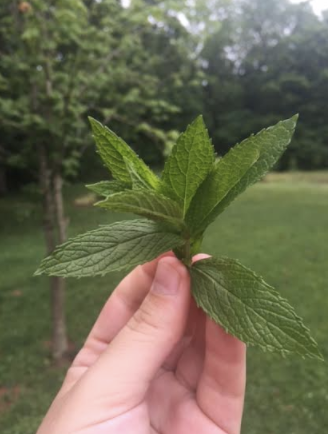This blog is part of the Farm to Face collection, which launches on November 1st. Each week we show you exactly how we made one of the ingredients that go inside of your beauty products. If you want to follow along the process, subscribe to updates here.
Spearmint (Mentha Spicata)
The most gentle of all the mints – which you can decipher when you smell and taste the leaves – this week we’re talking about our final ingredient: spearmint. Peppermint is seen as potentially volatile and irritating, but spearmint not so much.
Spearmint has a long history as a medicine, tea, and herb for cooking. It’s been used for centuries globally much in the same way that it’s used today.

Why We Chose It: Spearmint Oil (Mentha Spicata)
Spearmint is another unknown skincare ingredient.
For the most part, it’s been eschewed as another sensitizing ingredient (source), but again, that’s talking about the volatile essential oil, not an infusion. A little bad press won’t stop us from digging further into the research. ?
As part of the same family as lavender, spearmint actually contains the same monoterpenes, as well as rosmarinic acid, just like sage.
However, spearmint has an even higher concentration of rosmarinic acid that sage, coming in at 59 mg/g, or over 8x the concentration of rosmarinic acid in rosemary, and about 1.5x of that found in sage (source).
Again, rosmarinic acid is highly anti-inflammatory, making spearmint oil — not spearmint essential oil — a good candidate for a soothing face oil (like REWIND) or calming oil for irritation and skin afflictions (like CALM).
As we covered in the last blog about sage (here), rosmarinic acid is also a great regulator for melanin (source), making spearmint another good player in REWIND. Not just rosmarinic acid–but potentially also rosmarinic acid in combination with sage extract, which we already have in REWIND–help with melanogenesis.
Rosmarinic acid also helps alleviate signs of oxidative stress (source), and is strongly antioxidant.
As for the other constituents, spearmint’s scent comes from carvone (much like lavender’s scent comes from linalool) which helps alleviate stress from the body (source).
Finally, research suggests that terpenes enhance the penetration of key ingredients into the skin (source). So we expect that spearmint will not only act as an anti-oxidant, oxidative stress reliever, and anti-inflammatory agent to the skin, but it will also help the other key ingredients penetrate deeper, too.
Where We Got It: Spearmint (Mentha Spicata)
Spearmint is another herb that’s been in my family for quite a while. I don’t know the exact origin of the spearmint, but I’ve picked and used it my entire life. Chewed it, made tea out of it – I’ve always been quite fascinated with it.

Spearmint is very easy to grow and spreads like a weed. You won’t need a lot of it in any given formulation, so it won’t be difficult to grow enough to meet your beauty needs ?
How We Made It: Spearmint (Mentha Spicata)
Ok! Enough, enough already, I know. We used the Folk Method to extract the spearmint, using jojoba oil (jojoba + terpenes = great penetration). So yes, all of our ingredients were extracted this way (but that doesn’t mean that future batches will all be extracted this way *hint*hint*)

The spearmint leaves diffused their scent into the oil–yay carvones!–and the leaves retained very little of the oil, given their thin membranes, so it was easy to press out the oil. Almost 100% of the oil was retained from the beginning to the end of the process, which is amazing.

